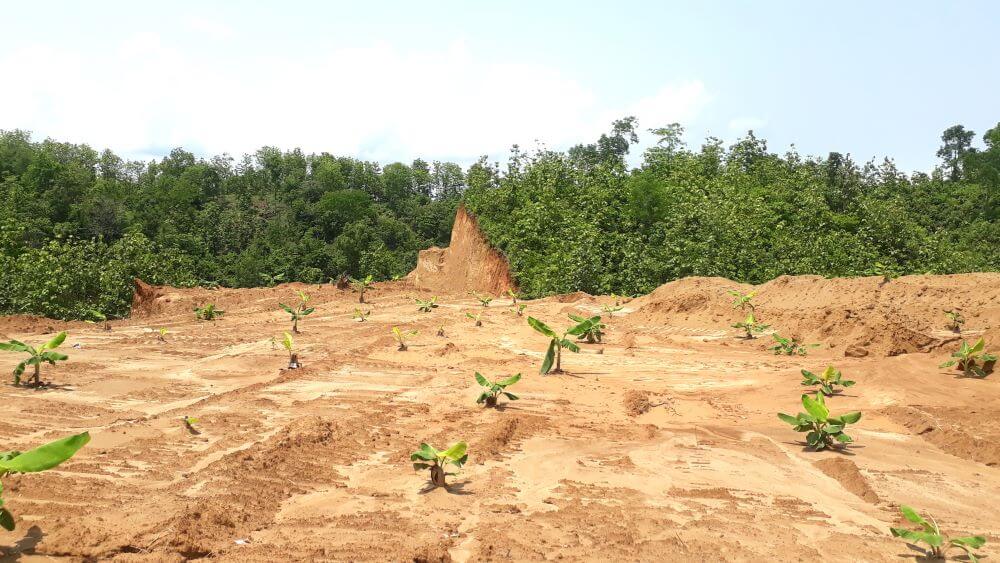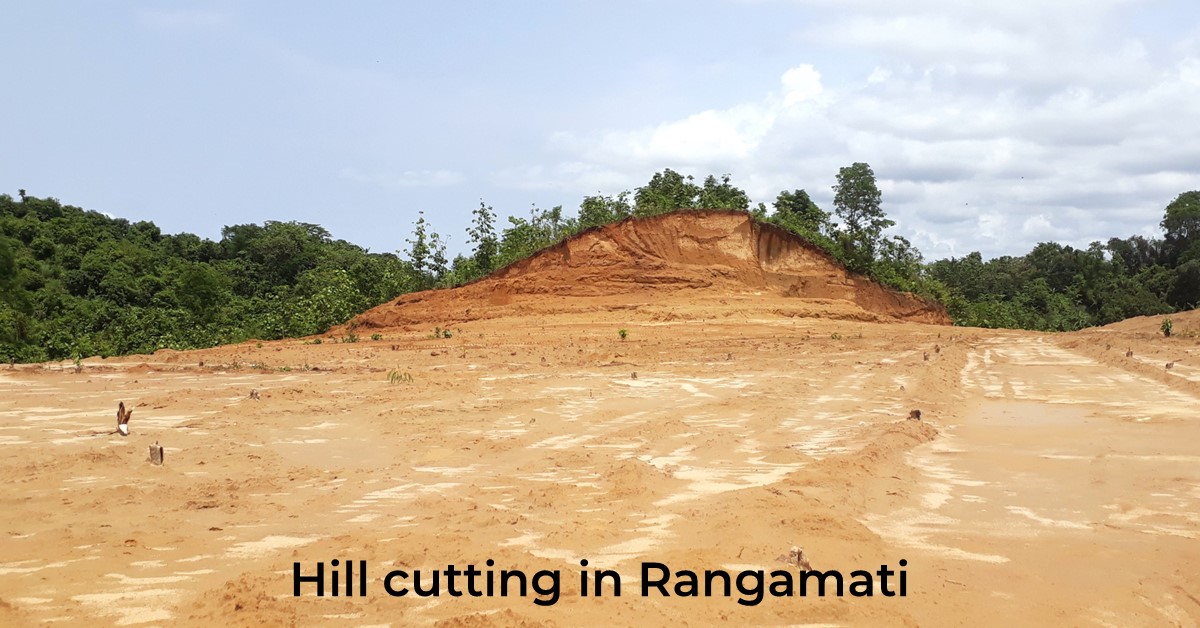Hill cutting in Bangladesh and the heart-breaking deforestation 2023
Last updated on September 8th, 2023 at 04:22 pm
Deforestation, forest degradation, hill cutting, and filling up of ponds, natural water reservoirs, canals and rivers have been the man-made atrocities being done on nature. Men, the supposed protectors of nature, have turned into its violators. The violations against mother earth are rampant everywhere in the world. Just as in other places, Bangladesh frequently experiences deforestation and hill cutting on a greater scale.
Forest of the hill tracts
My visit to exotic Rangamati, one of the hill tract districts of Bangladesh, in the Chittagong division, turn into a heartbreaking one every time. It breaks my heart to see the pictures of rapid urbanization, growing population, continual expansion of the cities, cutting of hills, and deforestation. In ten years, I witnessed the extensive extension of Rangamati town with more population hundreds of concrete buildings, including shopping malls, mosques, vehicles, government offices, residential hotels, and residential apartments scattered all over the district. In fact, hill cutting in Bangladesh is a regular atrocity to nature.
Hill tracts cities, like Rangamati, have almost all the growing urban facilities but decreasing nature and natural beauties. Cities like this were supposed to be dominated or primed by local indigenous people who are completely dependent on nature for survival and thereby care for it. But now they are buzzing with the majority of Bangalee settlers. Bangalees occupy almost all local and state affairs in the areas. More than often, they terrorize the down-to-earth local people, appropriate their means of survival, abduct their girls, and are subjected to discrimination.
Just after the Sundarban of Bangladesh part, Chittagong Hill Tracts (CHT) is the second largest forest reserve in the country with 322, 331 hectares of area. The 1865 Act of the British Government in 1865 barred the forest-dwelling people from their customary right to the forest land. Due to commercial afforestation, the cultivation of exotic species began in the hills. However, the construction of the Kaptai hydropower dam, roads, social forestry, paper mills, militarization, and the Bangalee settlement greatly damaged the beauty of the area. The atrocities against nature kicked off with the advent of modernity and modern form lifestyle.
Local ethnic people now are more disoriented, and displaced, with more Bengalee settlers, and more Bengalee dominance over the aboriginal people who are now foreigners in their own land. Every day they are losing their right to their land only to become more dependent on urban works than on nature, the mountains, and the hills which have been providing them with necessities for thousands of years. Instead of depending on nature, these down-to-earth people now are becoming dependent on trade, extortion, illegal activities and rebellion to sustain themselves. Resentment between the settlers and the locals in intensifying gradually.
Gradually the national identity, ‘Bangalism’ or ‘Bangaliness’ has been imposed on the non-Bengali indigenous people disregarding their own cultural identity which resulted in the non-Bengali separatist group, Kuki-Chin in the Chittagong Hill Tracts. Their revolts, I think, are to protect their cultural identities. They can be called Bangladeshis, but not Bengalese or Bangalees.
The unmindful and reckless development spree in the hill tracts area causing environmental hazards. The numerous numbers of brick clinks in such exotic vegetation broke my heart. Indiscriminate hill-cutting, tree felling, and deforestation no know bound of human greed. I literally wept to see the hill-cutting at the Vedvedi sub-district of Rangamati. The buzzing sound of crickets and chirping of birds in the nest holes on the wall of the freshly cut hill kept me bemused for a while.
I heard half of the hill has already been sold to many who intended to build business enterprises and religious institutions in the future in the remote part where one can only hear the buzzing of insects and chirping of birds all around. People cannot be crueller to nature than to destroy the habitats of animals and turn them into profitable avenues.
The report says that 120 hills have been destroyed and disappeared in Chittagong city alone in Bangladesh, let alone the whole country. 40 per cent of the hills disappeared in 4 decades in Chittagong. Powerful people are seen to be levelling hills and hillocks across the country. People are using power in cutting hills, felling trees, encroaching on reserved lands, and filling the rivers and canals across the country.
In places where enforcing the law is cumbersome and time-bound, the owner or grabbers cut and sell away the part of the hill without the government’s knowledge or permission, I think, though a punishable crime. The man who took me to the Vedvedi site told me that the owner, at last, got the approval of cutting and selling the hill after fighting environmental litigation with the movement or the Environment Department of the country. But still, how can the government allow to deforest and cut such a huge and beautiful hill is beyond me.
Nevertheless, the people of the world and that of Bangladesh are already facing the consequences of deforestation. Along with the environmental disaster propelled by the recent Rohingya Crisis, the country is losing vegetation every day to rapid urbanization, housing facilities, human accommodation, fisheries, industries, shops, resorts, farming, pasturing, salt farms, and gardening. The dense forests that I grew up with in the Teknaf region have been cleared up and the millions of Shenun trees (teak) have been swallowed by local forest eaters.
There are 1,331,469.02 hectares of reserved forest lands, 12.8 per cent of total land, in Bangladesh, according to the Forest Department’s 2016 gazette notification. But 56,094.71 hectares of forest lands have been encroached by 88,215 encroachers across the country. 1,920,000 hectares of forest land in 1990 diminished to 1,883,000 hectares in 2020.
David Attenborough said worldwide we have destroyed half of the plants that once flourished our planet. According to the Food and Agriculture Organization of the United Nations’ (FAO) Global Forest Resources Assessment 2020, in 2020 the global share of forest area is 4.06 billion hectares, 31 per cent of the total land area.
However, the forest area continues to shrink by an average of 4.7 million hectares per year globally. In the period of 2015-2020 the global deforestation occurred at a rate of 10 million hectares per year. An estimated 420 million hectares of forest area was lost to deforestation in between 1990 and 2020 at the rate of 15.8 million hectares per year, 15.1 million ha per year in 2000–2010, 11.8 million hectares in 2010–2015, and 10.2 million ha per year in 2015–2020.
54 per cent of global forest area is in the five countries– the Russian Federation, Brazil, Canada, the United States of America, and China, whereas Africa had the highest share of net loss of forest area in the decade to 2020, with Eastern and Southern Africa and Western and Central Africa accounting for most of the losses.
According to the SDGs of 2030 agenda, 40,000 species are documented to be at risk of extinction over the coming decades. The World Bank’s estimation tells that by 2050 Bangladesh will see 13.3 million climate refugees which are 216 million worldwide.




Roles of Forest
Forest’s role in the earth’s climate system is multipurpose. Forests absorb carbon dioxide from the atmosphere and turn it into photosynthesis and biomass. absorbed through leaf litter Forest stores carbon in forest soil and woody debris.
In 2000 the Intergovernmental Panel on Climate Change (IPCC) estimated that a total volume of 1,100 gigatonnes (Gt, or billion tonnes) of carbon found to be stored by the forest globally, the amount larger than carbon stored in fossil fuel reserves (800 Gt, estimated). It is also a bigger amount than the carbon emitted by human (about 600 Gt) activities to the atmosphere since 1870. Since 1750, forests sequestered half of the carbon emission naturally from the atmosphere.
On the contrary, deforestation exacerbates climate change. The net flow of carbon from the atmosphere into the forest ends due to deforestation through burning or clearing the forest for cropland, pasture, infrastructures or urbanization. It also causes to release of the accumulated carbon stock in trees and the forest soil. The study shows that the clearance of tall, dense forests produces more carbon emissions per unit of land area than clearing low, sparse forests.
Forests also play important roles in producing and regulating the world’s temperatures and freshwater flows while they contribute to atmospheric moisture and rainfall patterns over land through evapotranspiration. Evapotranspiration is responsible for at least 40 per cent of rainfall over land. However, forest loss and degradation reduce evapotranspiration.
Reasons of deforestation
•Commodity-driven deforestation – permanent conversion of forests for the expansion of commodities such as palm oil. (Overall, there is an estimated 11.8 million ha of palms in 94 countries and territories, mostly in Asia, soy, beef (an estimated 7.20 billion hectares of land was burned in 2001–2018 at an average of just more than 400 million hectares per year, (according to data prepared by the Joint Research Centre of the European Commission), for agriculture and grazing facilities, minerals and oil and gas.
• Forestry – loss within managed forests and tree plantations, which are expected to regrow after harvest.
• Shifting agriculture – loss, primarily in tropical regions, through clearance and burning for short-term cultivation of subsistence crops. These forests may or may not grow back, depending on the cultivation practices.
• Wildfires – loss from fires; trees are likely to regenerate gradually over time. Over this period (2001–15) this loss was concentrated in the northern forests of Canada and Russia.
• Urbanisation – loss from urban expansion; considered permanent, concentrated.
The world is getting urbanized every passing day. We have entered the Anthropocene – an era when humans are a dominant geological force – and at the same time, we have entered an Urban Age. The UN reports expect that by 2050 the world population will reach to 9.2 billion, and most of the population growth will take place in urbanized settings in the less developed countries.
Although urbanization is often seen as a positive development, if the current rapid urbanization continues it can outstretch the capacities of cities to absorb and cater for an ever-growing number of inhabitants.
The global share of the urban population was merely 13 per cent in 1900. But the share of the urban population in 1950 was 29 per cent while in 2008 it reached to 50 per cent, by 2030, 60 per cent and in 2050 the percentage will be 70 or 6.3 billion, doubling the 3.5 billion urban dwellers in 2010. In other words, from 2010 to 2030 another one-and-a-half billion population will be added to the cities.
Conclusion
From hill cutting to deforestation to urbanization, the human beings on the planet earth cannot afford to bear the cost of any. What horrifies me is the degree to which deforestation is taking place around the world, especially in Bangladesh. Cutting hills and hillocks for housing, cultivation, and urbanization is another form of deforestation. Along with forest degradation or forest disturbances, deforestation affects 1.6 billion people around the globe who are dependent on the forest.
People’s lives are linked to the wellness of the forest and the species sustained by the forest. Not only it provides an ecological balance by controlling the weather of the atmosphere, but forests are also an incomparable source of beauty that greedy people are destroying unscrupulously. No matter the reason, the destruction and demolition of hills pains me always just as unmindful urbanization.
I do not understand why humanity needs so much of development to survive that to at the cost of nature and ecological beauty. The more we take for granted the development at the cost of nature, the more deforestation we will see, and the more we will distance ourselves from natural beauty and livelihood, the more our lives in urbanized settings will become unliveable.
Crucial action is needed to halt deforestation and to incentivize afforestation, forest restoration and forest conservation, especially in tropical developing countries. Such action is necessary if the world is to meet commitments to halt deforestation, increase forest area, and restore 420 million hectares of the world’s lost forest to deforestation and degradation.
Even though SDG indicator 15 is designated to “Protect, restore and promote sustainable use of terrestrial ecosystems, sustainably manage forests, combat desertification, and halt and reverse land degradation and halt biodiversity loss”, it is still questionable how much of the goals are achieved in ensuring the conservation, restoring forests, wetlands, mountains and drylands.
UN’s formulated indicator 15 to implement sustainable management of all types of forests, halt deforestation, restore degraded forests and substantially increase afforestation and reforestation globally call for immediate and radical actions, while at the same time imperative to reduce the degradation of natural habitats, stop the loss of biodiversity and protect and prevent the extinction of threatened species.
The extent of diminishing our nature, deforestation, forest degradation, encroaching wetland, forestland, cutting hills, building brick clinks, unbridled urbanization, and settlement in the areas meant for the indigenous people must come to a halt. Conservation, restoration, sustainable use of forestland, afforestation, and reforestation are in our hands. We are the executors of sustainable goals, custodians, and protectors of nature.
Reference
- The New Geography of Contemporary Urbanization and the Environment by Karen C. Seto, et al.
- Urbanization, Biodiversity and Ecosystem Services: Challenges and Opportunities A Global Assessment Foreword by Pavan Sukhdev.
- Forests and Climate Change 2019 assessment by United Nations.
- Global Forest Resources Assessment 2020 by United Nations.
- Rapid Urbanisation and Food Security: Using Food Density Maps To Identify Food Security Hotspots By Food And Agriculture Organisation Of The United Nations (FAO).






